Variation in Vegetation Phenology and Its Response to Climate Change in Marshes of Inner Mongolian
Abstract
1. Introduction
2. Results
2.1. Changes in the Phenology of Marshes in Inner Mongolia from 2001 to 2020
2.2. Correlations between Climatic Factors and Phenology in Marshes of Inner Mongolia from 2001 to 2020
3. Discussion
3.1. Spatiotemporal Changes in Phenology in Marshes of Inner Mongolia during 2001–2020
3.2. Correlations between Climate Factors and Marsh Vegetation Phenology
3.3. Limitations
4. Materials and Methods
4.1. Study Area
4.2. Data
4.3. Method
5. Conclusions
Author Contributions
Funding
Data Availability Statement
Conflicts of Interest
References
- Yang, P.; Zhang, L.; Lai, D.Y.; Yang, H.; Tan, L.; Luo, L.; Tong, C.; Hong, Y.; Zhu, W.; Tang, K.W. Landscape Change Affects Soil Organic Carbon Mineralization and Greenhouse Gas Production in Coastal Wetlands. Glob. Biogeochem. Cycles 2022, 36, e2022GB007469. [Google Scholar] [CrossRef]
- Smith, A.; Kirwan, M. Sea level-driven marsh migration results in rapid net loss of carbon. Geophys. Res. Lett. 2021, 48, e2021GL092420. [Google Scholar] [CrossRef]
- Keppeler, F.; Olin, J.; López-Duarte, P.; Polito, M.; Hooper-Bùi, L.; Taylor, S.; Rabalais, N.; Fodrie, F.; Roberts, B.; Turner, R.; et al. Body size, trophic position, and the coupling of different energy pathways across a saltmarsh landscape. Limnol. Oceanogr. Lett. 2021, 6, 360–368. [Google Scholar] [CrossRef]
- Ribeiro, K.; Pacheco, F.; Ferreira, J.; de Sousa-Neto, E.; Hastie, A.; Krieger Filho, G.; Alvalá, P.; Forti, M.; Ometto, J. Tropical peatlands and their contribution to the global carbon cycle and climate change. Glob. Chang. Biol. 2021, 27, 489–505. [Google Scholar] [CrossRef]
- Coleman, D.; Schuerch, M.; Temmerman, S.; Guntenspergen, G.; Smith, C.; Kirwan, M. Reconciling models and measurements of marsh vulnerability to sea level rise. Limnol. Oceanogr. Lett. 2022, 7, 140–149. [Google Scholar] [CrossRef]
- Molino, G.; Carr, J.; Ganju, N.; Kirwan, M. Variability in marsh migration potential determined by topographic rather than anthropogenic constraints in the Chesapeake Bay region. Limnol. Oceanogr. Lett. 2022, 7, 321–331. [Google Scholar] [CrossRef]
- Cai, X.; Qin, Q.; Shen, J.; Zhang, Y.J. Bifurcate responses of tidal range to sea-level rise in estuaries with marsh evolution. Limnol. Oceanogr. Lett. 2022, 7, 210–217. [Google Scholar] [CrossRef]
- Hu, Z.; Borsje, B.; van Belzen, J.; Willemsen, P.W.J.M.; Wang, H.; Peng, Y.; Yuan, L.; De Dominicis, M.; Wolf, J.; Temmerman, S.; et al. Mechanistic modeling of marsh seedling establishment provides a positive outlook for coastal wetland restoration under global climate change. Geophys. Res. Lett. 2021, 48, e2021GL095596. [Google Scholar] [CrossRef]
- Pasut, C.; Tang, F.; Hamilton, D.; Riley, W.J.; Maggi, F. Spatiotemporal assessment of GHG emissions and nutrient sequestration linked to agronutrient runoff in global wetlands. Glob. Biogeochem. Cycles 2021, 35, e2020GB006816. [Google Scholar] [CrossRef]
- Rietl, A.; Megonigal, J.; Herbert, E.; Kirwan, M. Vegetation type and decomposition priming mediate brackish marsh carbon accumulation under interacting facets of global change. Geophys. Res. Lett. 2021, 48, e2020GL092051. [Google Scholar] [CrossRef]
- Shen, X.; Jiang, M.; Lu, X.; Liu, X.; Liu, B.; Zhang, J.; Wang, X.; Tong, S.; Lei, G.; Wang, S.; et al. Aboveground biomass and its spatial distribution pattern of herbaceous marsh vegetation in China. Sci. China Earth Sci. 2021, 64, 1115–1125. [Google Scholar] [CrossRef]
- Shen, X.; Liu, B.; Jiang, M.; Lu, X. Marshland loss warms local land surface temperature in China. Geophys. Res. Lett. 2020, 47, e2020GL087648. [Google Scholar] [CrossRef]
- Hirota, M.; Tang, Y.; Hu, Q.; Hirata, S.; Kato, T.; Mo, W.; Cao, G.; Mariko, S. Carbon dioxide dynamics and controls in a deep-water wetland on the Qinghai-Tibetan Plateau. Ecosystems 2006, 9, 673–688. [Google Scholar] [CrossRef]
- Byomkesh, T.; Nakagoshi, N.; Md Shahedur, R. State and management of wetlands in Bangladesh. Landsc. Ecol. Eng. 2009, 5, 81–90. [Google Scholar] [CrossRef]
- Adam, E.; Mutanga, O.; Rugege, D. Multispectral and hyperspectral remote sensing for identification and mapping of wetland vegetation: A review. Wetl. Ecol. Manag. 2010, 18, 281–296. [Google Scholar] [CrossRef]
- Grünzweig, J.; De Boeck, H.; Rey, A.; Santos, M.; Adam, O.; Bahn, M.; Belnap, J.; Deckmyn, G.; Dekker, S.C.; Flores, O.; et al. Dryland mechanisms could widely control ecosystem functioning in a drier and warmer world. Nat. Ecol. Evol. 2022, 6, 1064–1076. [Google Scholar] [CrossRef]
- Workie, T.G.; Debella, H.J. Climate change and its effects on vegetation phenology across ecoregions of Ethiopia. Glob. Ecol. Conserv. 2018, 13, e00366. [Google Scholar] [CrossRef]
- Fu, B.; Lan, F.; Yao, H.; Qin, J.; He, H.; Liu, L.; Huang, L.; Fan, D.; Gao, E. Spatio-temporal monitoring of marsh vegetation phenology and its response to hydro-meteorological factors using CCDC algorithm with optical and SAR images: In case of Honghe National Nature Reserve, China. Sci. Total Environ. 2022, 843, 156990. [Google Scholar] [CrossRef]
- Shen, X.; Liu, B.; Xue, Z.; Jiang, M.; Lu, X.; Zhang, Q. Spatiotemporal variation in vegetation spring phenology and its response to climate change in freshwater marshes of Northeast China. Sci. Total Environ. 2019, 666, 1169–1177. [Google Scholar] [CrossRef]
- Hughes, L. Climate change and Australia: Trends, projections and impacts. Austral Ecol. 2003, 28, 423–443. [Google Scholar] [CrossRef]
- Piao, S.; Liu, Q.; Chen, A.; Janssens, I.A.; Fu, Y.; Dai, J.; Liu, L.; Lian, X.; Shen, M.; Zhu, X. Plant phenology and global climate change: Current progresses and challenges. Glob. Chang. Biol. 2019, 25, 1922–1940. [Google Scholar] [CrossRef] [PubMed]
- Bandoc, G.; Piticar, A.; Patriche, C.; Roșca, B.; Dragomir, E. Climate Warming-Induced Changes in Plant Phenology in the Most Important Agricultural Region of Romania. Sustainability 2022, 14, 2776. [Google Scholar] [CrossRef]
- Peichl, M.; Gažovič, M.; Vermeij, I.; Goede, E.; Sonnentag, O.; Limpens, J.; Mats, B. Peatland vegetation composition and phenology drive the seasonal trajectory of maximum gross primary production. Sci. Rep. 2018, 8, 8012. [Google Scholar] [CrossRef] [PubMed]
- Shen, X.; Jiang, M.; Lu, X. Diverse impacts of day and night temperature on spring phenology in freshwater marshes of the Tibetan Plateau. Limnol. Oceanogr. Lett. 2023, 8, 323–329. [Google Scholar] [CrossRef]
- Zheng, Y.; Liu, H.; Zhuo, Y.; Li, Z.; Liang, C.; Wang, L. Dynamic changes and driving factors of wetlands in Inner Mongolia Plateau, China. PLoS ONE 2019, 14, e0221177. [Google Scholar] [CrossRef]
- Lee, R.; Yu, F.; Price, K.P.; Ellis, J.; Shi, P. Evaluating vegetation phenological patterns in Inner Mongolia using NDVI time-series analysis. Int. J. Remote Sens. 2002, 23, 2505–2512. [Google Scholar] [CrossRef]
- Li, Q.; Xu, L.; Pan, X.; Zhang, L.; Li, C.; Yang, N.; Qi, J. Modeling phenological responses of Inner Mongolia grassland species to regional climate change. Environ. Res. Lett. 2016, 11, 015002. [Google Scholar] [CrossRef]
- Wang, G.; Huang, Y.; Wei, Y.; Zhang, W.; Li, T.; Zhang, Q. Inner Mongolian grassland plant phenological changes and their climatic drivers. Sci. Total Environ. 2019, 683, 1–8. [Google Scholar] [CrossRef]
- Ma, X.; Leng, P.; Liao, Q.; Geng, Y.; Zhang, X.; Shang, G.; Song, X.; Song, Q.; Li, Z.L. Prediction of vegetation phenology with atmospheric reanalysis over semiarid grasslands in Inner Mongolia. Sci. Total Environ. 2022, 812, 152462. [Google Scholar] [CrossRef]
- Qiao, D.; Wang, N. Relationship between winter snow cover dynamics, climate and spring grassland vegetation phenology in inner Mongolia, China. ISPRS Int. J. Geo-Inf. 2019, 8, 42. [Google Scholar] [CrossRef]
- Sha, Z.; Zhong, J.; Bai, Y.; Tan, X.; Li, J. Spatio-temporal patterns of satellite-derived grassland vegetation phenology from 1998 to 2012 in Inner Mongolia, China. J. Arid Land 2016, 8, 462–477. [Google Scholar] [CrossRef]
- Ren, S.; Yi, S.; Peichl, M.; Wang, X. Diverse responses of vegetation phenology to climate change in different grasslands in Inner Mongolia during 2000–2016. Remote Sens. 2017, 10, 17. [Google Scholar] [CrossRef]
- Liu, Y.; Shen, X.; Wang, Y.; Zhang, J.; Ma, R.; Lu, X.; Jiang, M. Spatiotemporal variation in aboveground biomass and its response to climate change in the marsh of Sanjiang Plain. Front. Plant Sci. 2022, 13, 1973. [Google Scholar] [CrossRef]
- Shen, X.; Liu, B.; Henderson, M.; Wang, L.; Wu, Z.; Wu, H.; Jiang, M.; Lu, X. Asymmetric effects of daytime and nighttime warming on spring phenology in the temperate grasslands of China. Agric. For. Meteorol. 2018, 259, 240–249. [Google Scholar] [CrossRef]
- Shen, X.; Liu, Y.; Zhang, J.; Wang, Y.; Ma, R.; Liu, B.; Lu, X.; Jiang, M. Asymmetric impacts of diurnal warming on vegetation carbon sequestration of marshes in the Qinghai Tibet Plateau. Glob. Biogeochem. Cycles 2022, 36, e2022GB007396. [Google Scholar] [CrossRef]
- Hu, Q.; Pan, F.; Pan, X.; Zhang, D.; Li, Q.; Pan, Z.; Wei, Y. Spatial analysis of climate change in Inner Mongolia during 1961–2012, China. Appl. Geogr. 2015, 60, 254–260. [Google Scholar] [CrossRef]
- Cui, L.; Shi, J. Evaluation and comparison of growing season metrics in arid and semi-arid areas of northern China under climate change. Ecol. Indic. 2021, 121, 107055. [Google Scholar] [CrossRef]
- Gong, Z.; Kawamura, K.; Ishikawa, N.; Goto, M.; Wulan, T.; Alateng, D.; Yin, T.; Ito, Y. MODIS normalized difference vegetation index (NDVI) and vegetation phenology dynamics in the Inner Mongolia grassland. Solid Earth 2015, 6, 1185–1194. [Google Scholar] [CrossRef]
- Deutsch, E.; Bork, E.; Willms, W. Separation of grassland litter and ecosite influences on seasonal soil moisture and plant growth dynamics. Plant Ecol. 2010, 209, 135–145. [Google Scholar] [CrossRef]
- Shen, X.; Xue, Z.; Jiang, M.; Lu, X. Spatiotemporal change of vegetation coverage and its relationship with climate change in freshwater marshes of Northeast China. Wetland 2019, 39, 429–439. [Google Scholar] [CrossRef]
- Li, X.; Guo, W.; Chen, J.; Ni, X.; Wei, X. Responses of vegetation green-up date to temperature variation in alpine grassland on the Tibetan Plateau. Ecol. Indic. 2019, 104, 390–397. [Google Scholar] [CrossRef]
- Post, A.; Hufkens, K.; Richardson, A. Predicting spring green-up across diverse North American grasslands. Agric. For. Meteorol. 2022, 327, 109204. [Google Scholar] [CrossRef]
- Liu, Q.; Fu, Y.H.; Zeng, Z.; Huang, M.; Li, X.; Piao, S. Temperature, precipitation, and insolation effects on autumn vegetation phenology in temperate China. Glob. Chang. Biol. 2016, 22, 644–655. [Google Scholar] [CrossRef] [PubMed]
- Ma, R.; Shen, X.; Zhang, J.; Xia, C.; Liu, Y.; Wu, L.; Wang, Y.; Jiang, M.; Lu, X. Variation of vegetation autumn phenology and its climatic drivers in temperate grasslands of China. Int. J. Appl. Earth Obs. 2022, 114, 103064. [Google Scholar] [CrossRef]
- Chen, K.; Ge, G.; Bao, G.; Bai, L.; Tong, S.; Bao, Y.; Chao, L. Impact of Extreme Climate on the NDVI of Different Steppe Areas in Inner Mongolia, China. Remote Sens. 2022, 14, 1530. [Google Scholar] [CrossRef]
- Ma, W.; Liu, Z.; Wang, Z.; Wang, W.; Liang, C.; Tang, Y.; He, J.; Fang, J. Climate change alters interannual variation of grassland aboveground productivity: Evidence from a 22-year measurement series in the Inner Mongolian grassland. J. Plant Res. 2010, 123, 509–517. [Google Scholar] [CrossRef]
- Wu, Z.; Dijkstra, P.; Koch, G.W.; Peñuelas, J.; Hungate, B.A. Responses of terrestrial ecosystems to temperature and precipitation change: A meta-analysis of experimental manipulation. Glob. Chang. Biol. 2011, 17, 927–942. [Google Scholar] [CrossRef]
- Shen, M.; Tang, Y.; Chen, J.; Zhu, X.; Zheng, Y. Influences of temperature and precipitation before the growing season on spring phenology in grasslands of the central and eastern Qinghai-Tibetan Plateau. Agric. For. Meteorol. 2011, 151, 1711–1722. [Google Scholar] [CrossRef]
- Pertille, R.; Citadin, I.; de Oliveira, L.; de Camargo, B.; Kvitschal, M.; Araujo, L. The influence of temperature on the phenology of apple trees grown in mild winter regions of Brazil, based on long-term records. Sci. Hortic. 2022, 305, 111354. [Google Scholar] [CrossRef]
- Piao, S.; Tan, J.; Chen, A.; Fu, Y.H.; Ciais, P.; Liu, Q.; Janssens, I.; Vicca, S.; Zeng, Z.; Jeong, S.; et al. Leaf onset in the northern hemisphere triggered by daytime temperature. Nat. Commun. 2015, 6, 6911. [Google Scholar] [CrossRef]
- Rina, W.; Bao, G.; Tong, S.; Bao, Y.; Shan, Y.; Huang, X.; Ying, H.; Du, L. Multi-Climate Factors and the Preceding Growth Stage of Vegetation Co-Regulated the Variation of the End of Growing Season in Northeast Inner Mongolia, China. IEEE Access 2020, 8, 221525–221538. [Google Scholar] [CrossRef]
- Shen, X.; Liu, B.; Jiang, M.; Wang, Y.; Wang, L.; Zhang, J.; Lu, X. Spatiotemporal change of marsh vegetation and its response to climate change in China from 2000 to 2019. J. Geophys. Res. Biogeosci. 2021, 126, e2020JG006154. [Google Scholar] [CrossRef]
- Trumble, J.; Kolodny-Hirsch, D.; Ting, I. Plant compensation for arthropod herbivory. Annu. Rev. Entomol. 1993, 38, 93–119. [Google Scholar] [CrossRef]
- Board, J. Light interception efficiency and light quality affect yield compensation of soybean at low plant populations. Crop Sci. 2000, 40, 1285–1294. [Google Scholar] [CrossRef]
- Belsky, A. Does herbivory benefit plants? A review of the evidence. Am. Nat. 1986, 127, 870–892. [Google Scholar] [CrossRef]
- Hawkes, C.V.; Sullivan, J.J. The impact of herbivory on plants in different resource conditions: A meta-analysis. Ecology 2001, 82, 2045–2058. [Google Scholar] [CrossRef]
- Wan, S.; Xia, J.; Liu, W.; Niu, S. Photosynthetic overcompensation under nocturnal warming enhances grassland carbon sequestration. Ecology 2009, 90, 2700–2710. [Google Scholar] [CrossRef]
- Yang, L.; Kirby, J.E.; Sunwoo, H.; Lee, J.T. Female mice lacking Xist RNA show partial dosage compensation and survive to term. Genes Dev. 2016, 30, 1747–1760. [Google Scholar] [CrossRef]
- Pei, Z.; Fang, S.; Yang, W.; Wang, L.; Wu, M.; Zhang, Q.; Han, W.; Khoi, D. The relationship between NDVI and climate factors at different monthly time scales: A case study of grasslands in inner Mongolia, China (1982–2015). Sustainability 2019, 11, 7243. [Google Scholar] [CrossRef]
- Piao, S.; Fang, J.; Zhou, L.; Ciais, P.; Zhu, B. Variations in satellite-derived phenology in China’s temperate vegetation. Glob. Chang. Biol. 2006, 12, 672–685. [Google Scholar] [CrossRef]
- Huang, W.; Ge, Q.; Wang, H.; Dai, J. Effects of multiple climate change factors on the spring phenology of herbaceous plants in Inner Mongolia, China: Evidence from ground observation and controlled experiments. Int. J. Climatol. 2019, 39, 5140–5153. [Google Scholar] [CrossRef]
- Tong, S.; Li, X.; Zhang, J.; Bao, Y.; Bao, Y.; Na, L.; Si, A. Spatial and temporal variability in extreme temperature and precipitation events in Inner Mongolia (China) during 1960–2017. Sci. Total Environ. 2019, 649, 75–89. [Google Scholar] [CrossRef] [PubMed]
- Fang, X.; Wu, J.; He, C. Assessing human-environment system sustainability based on Regional Safe and Just Operating Space: The case of the Inner Mongolia Grassland. Environ. Sci. Policy 2021, 116, 276–286. [Google Scholar] [CrossRef]
- Mao, D.; Wang, Z.; Du, B.; Li, L.; Tian, Y.; Jia, M.; Zeng, Y.; Song, K.; Jiang, M.; Wang, Y. National wetland mapping in China: A new product resulting from object based and hierarchical classification of Landsat 8 OLI images. ISPRS J. Photogramm. 2020, 164, 11–25. [Google Scholar] [CrossRef]
- Yang, Y.; Guan, H.; Shen, M.; Liang, W.; Jiang, L. Changes in autumn vegetation dormancy onset date and the climate controls across temperate ecosystems in China from 1982 to 2010. Glob. Chang. Biol. 2015, 21, 652–665. [Google Scholar] [CrossRef]
- Zhou, X.; Geng, X.; Yin, G.; Hänninen, H.; Hao, F.; Zhang, X.; Fu, Y.H. Legacy effect of spring phenology on vegetation growth in temperate China. Agric. For. Meteorol. 2020, 281, 107845. [Google Scholar] [CrossRef]
- Fan, J.; Min, J.; Yang, Q.; Na, J.; Wang, X. Spatial-Temporal Relationship Analysis of Vegetation Phenology and Meteorological Parameters in an Agro-Pasture Ecotone in China. Remote Sens. 2022, 14, 5417. [Google Scholar] [CrossRef]

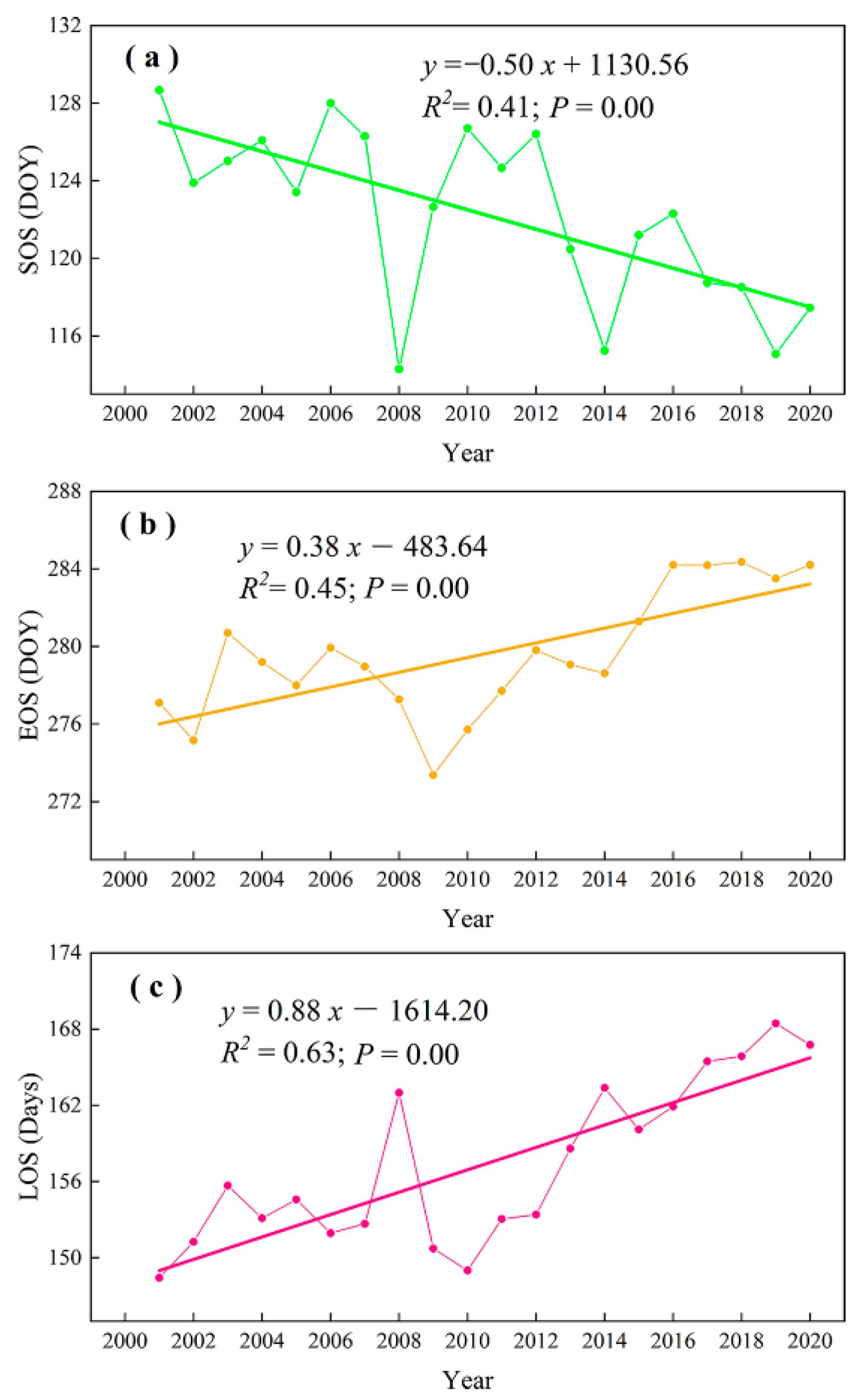
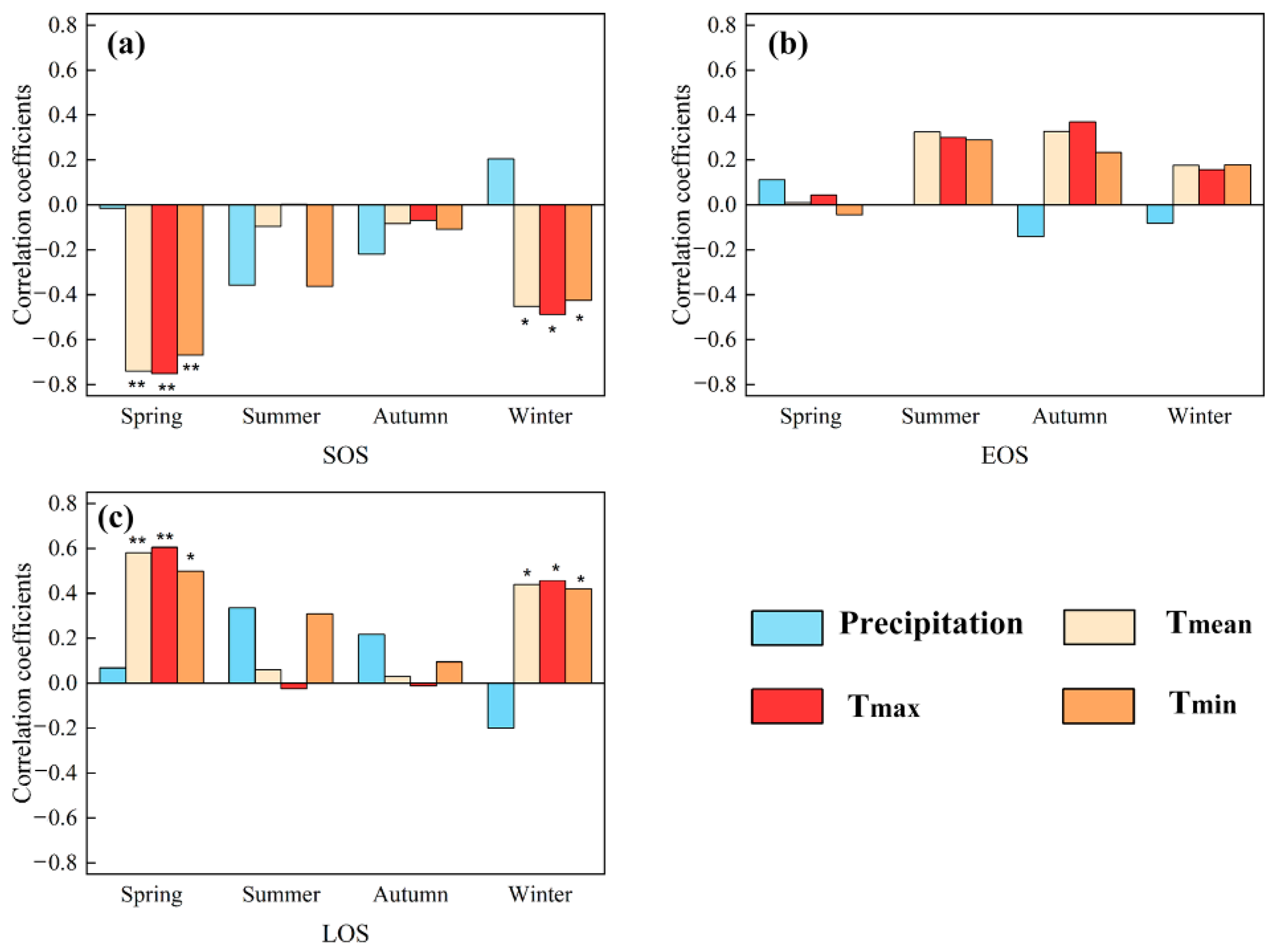

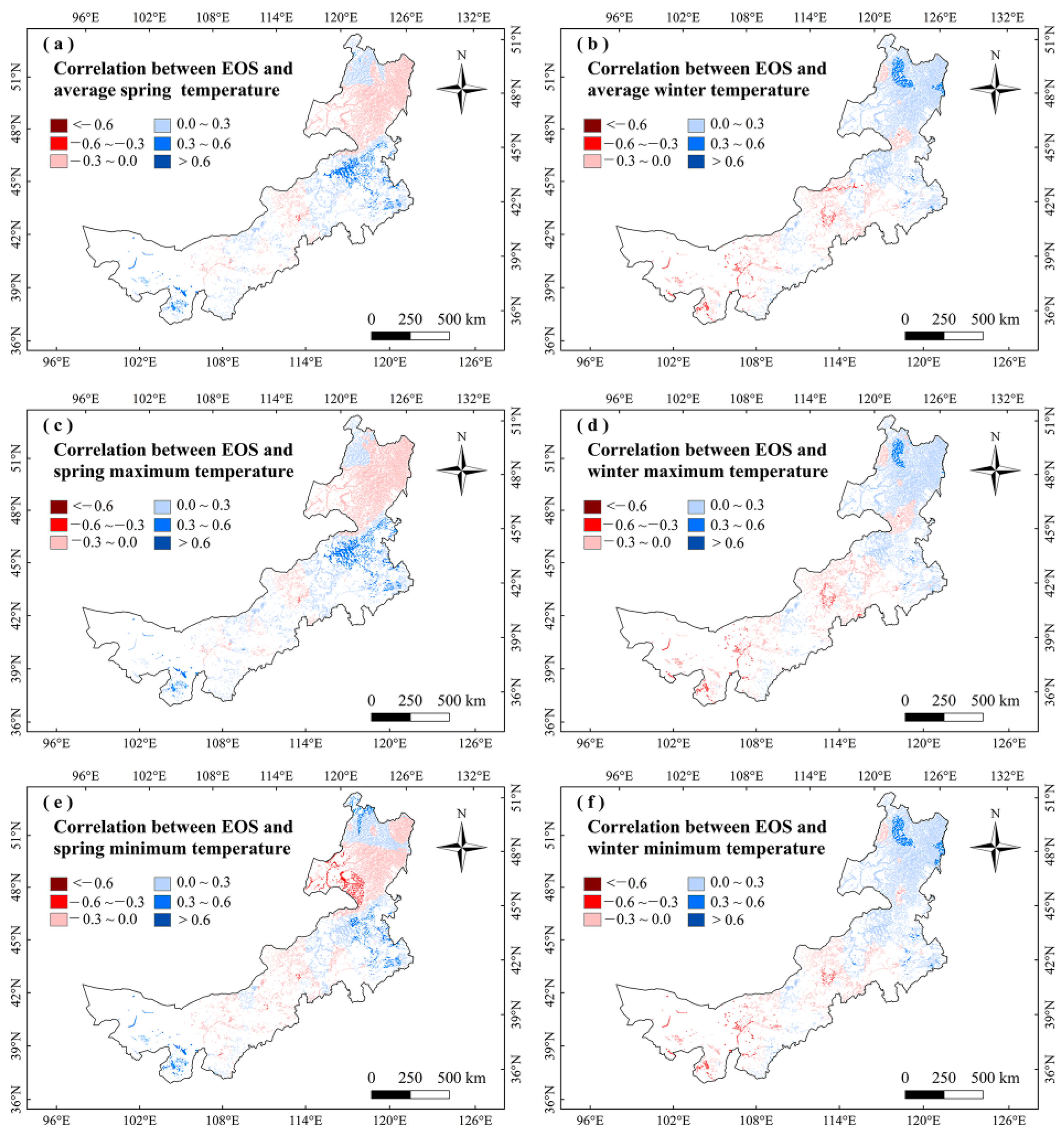
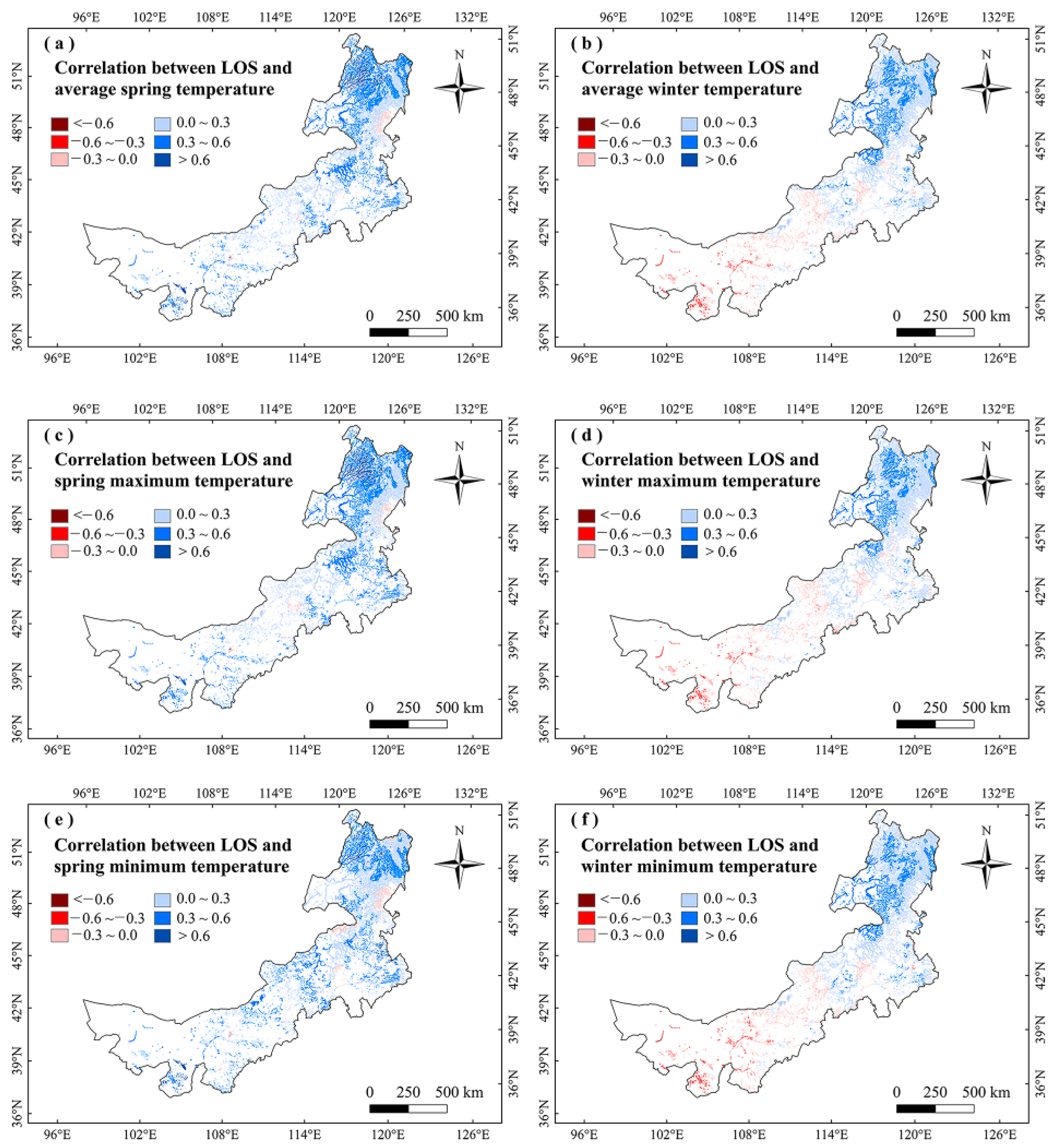
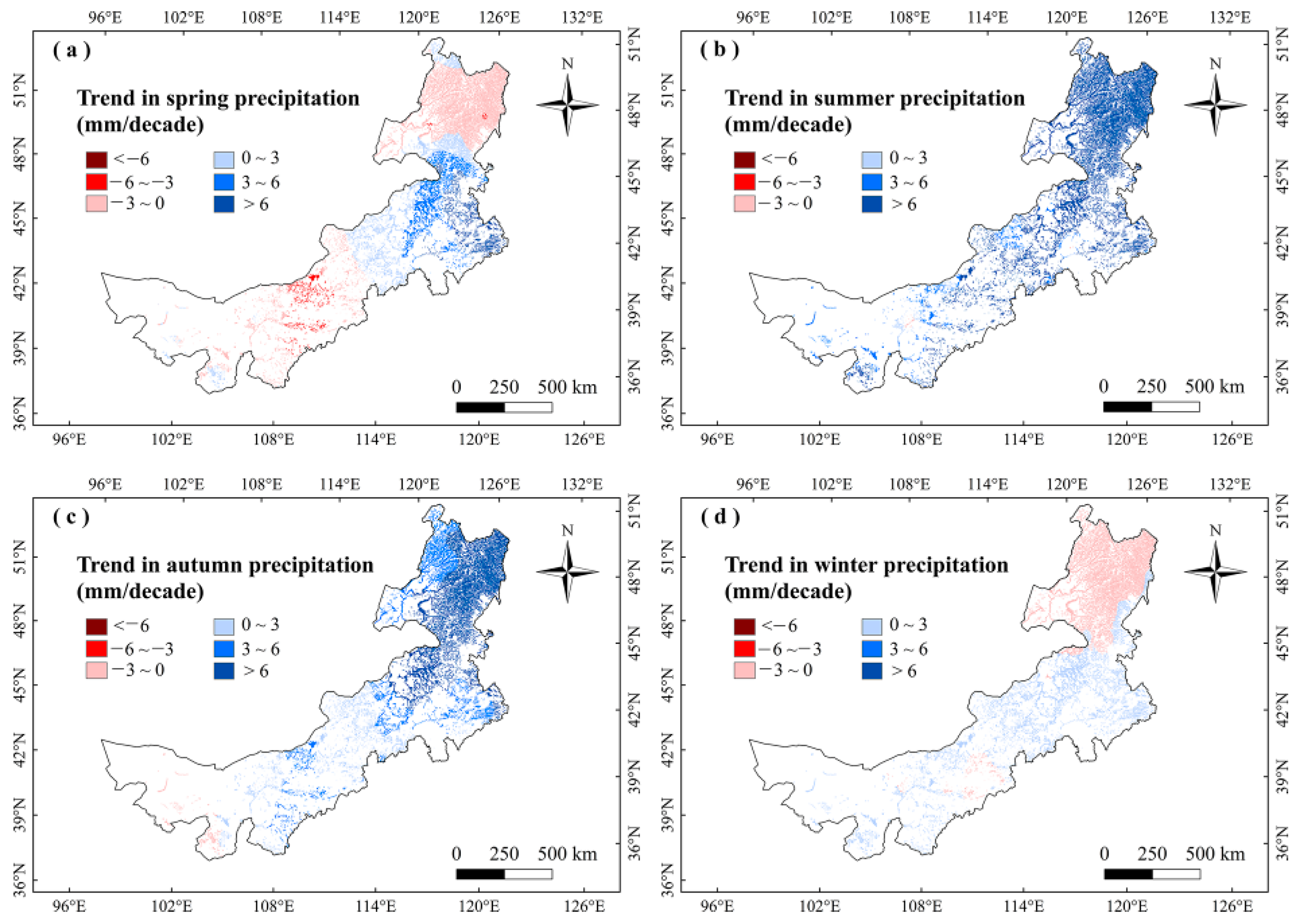
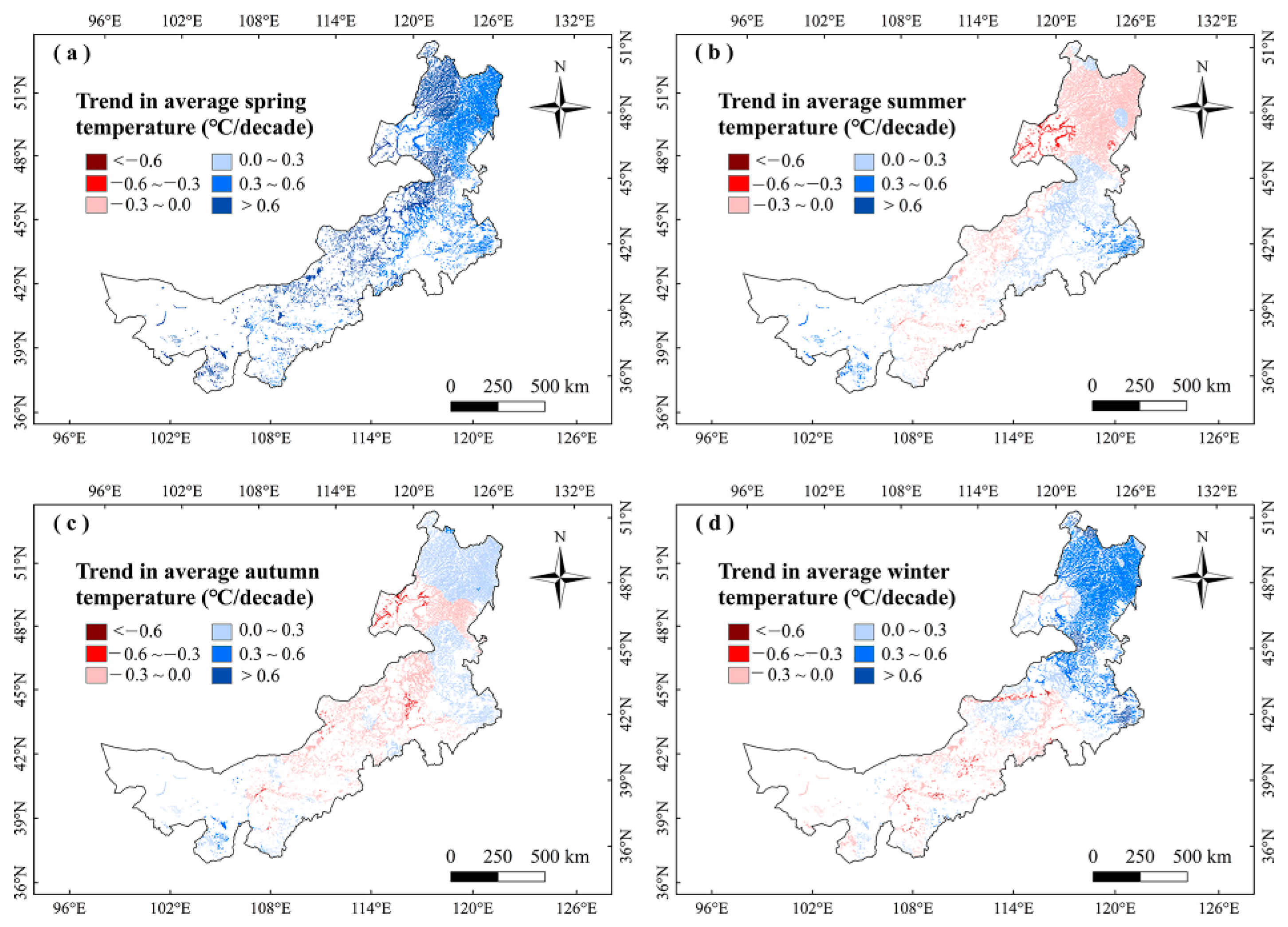
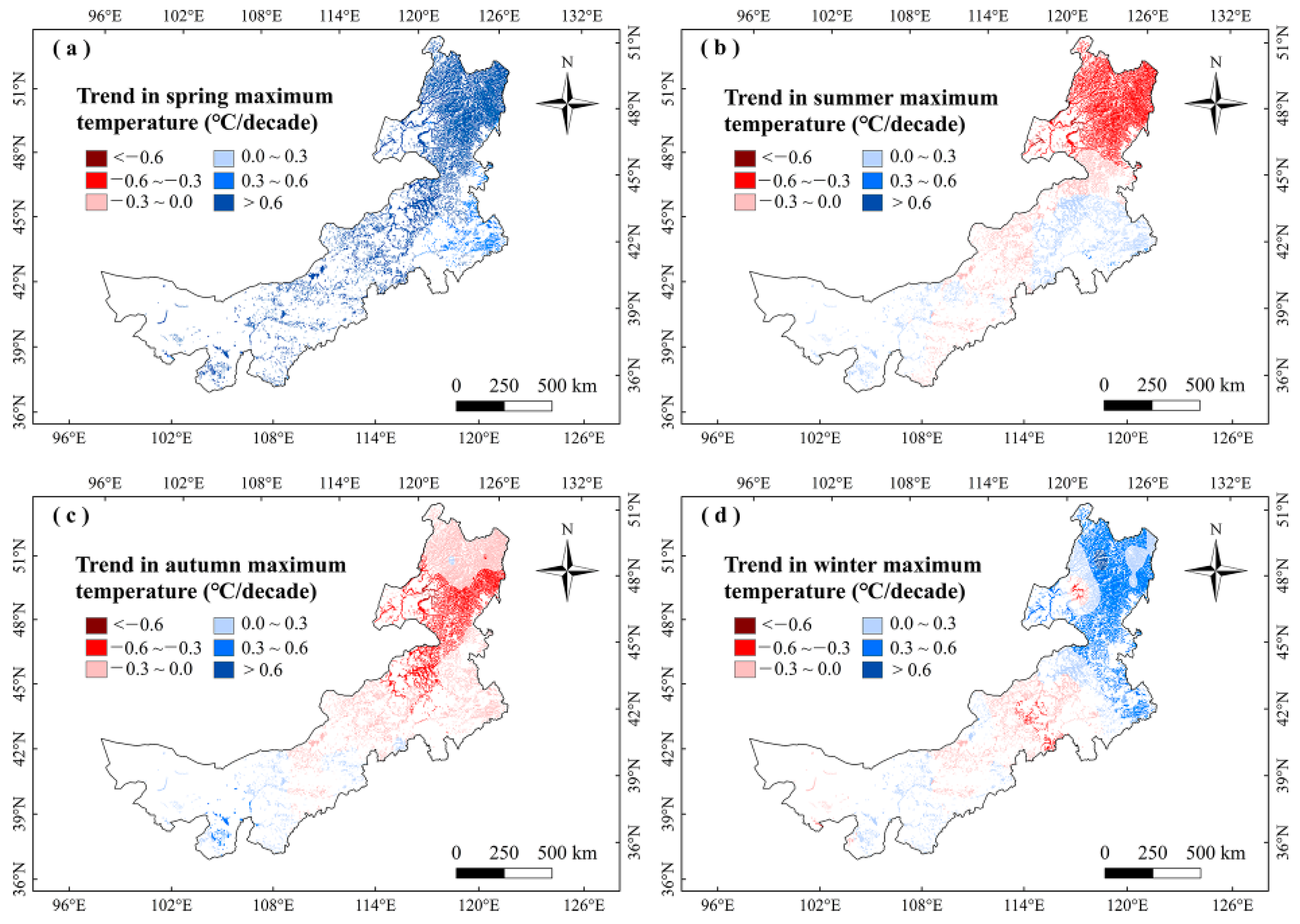
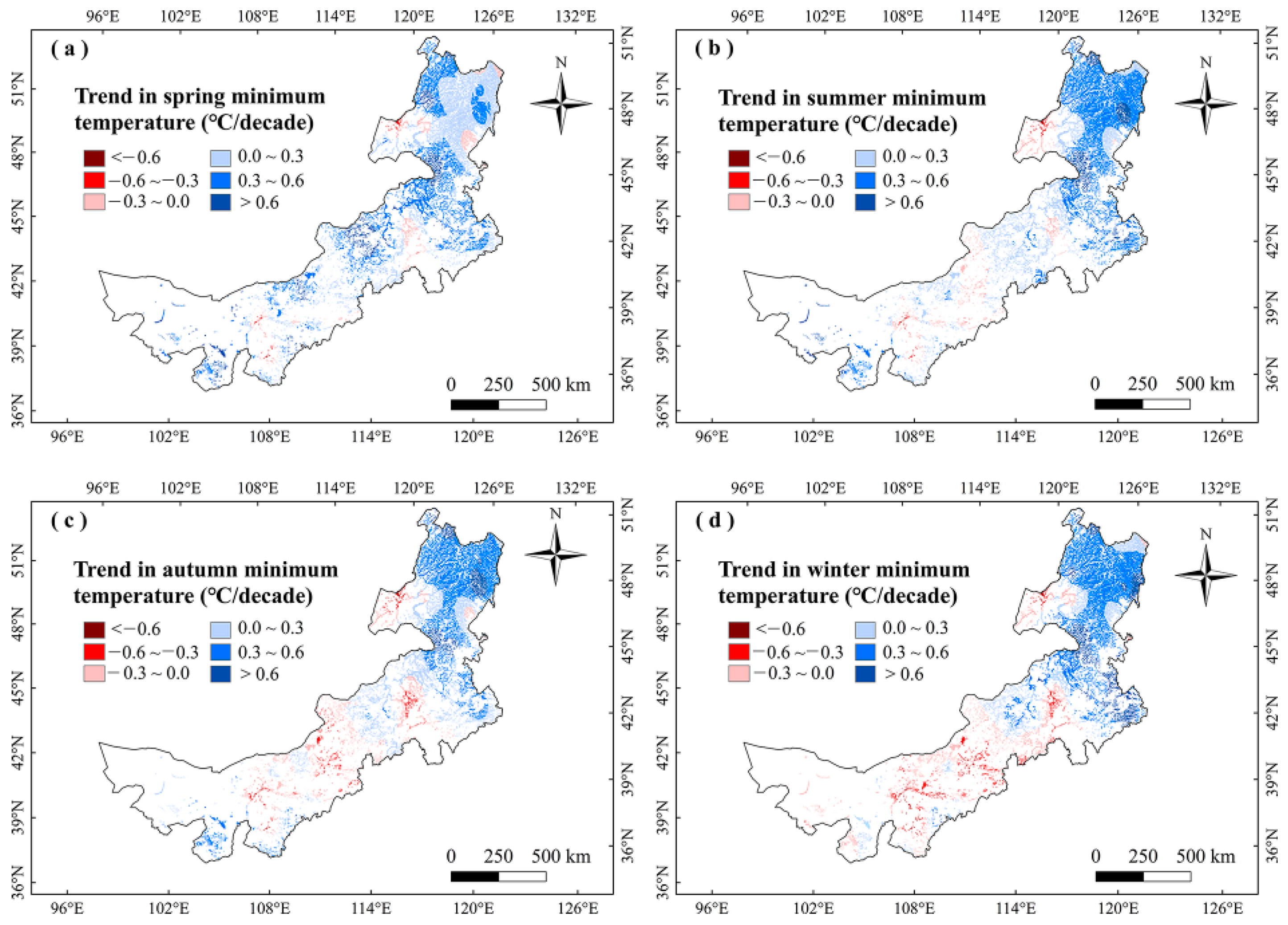
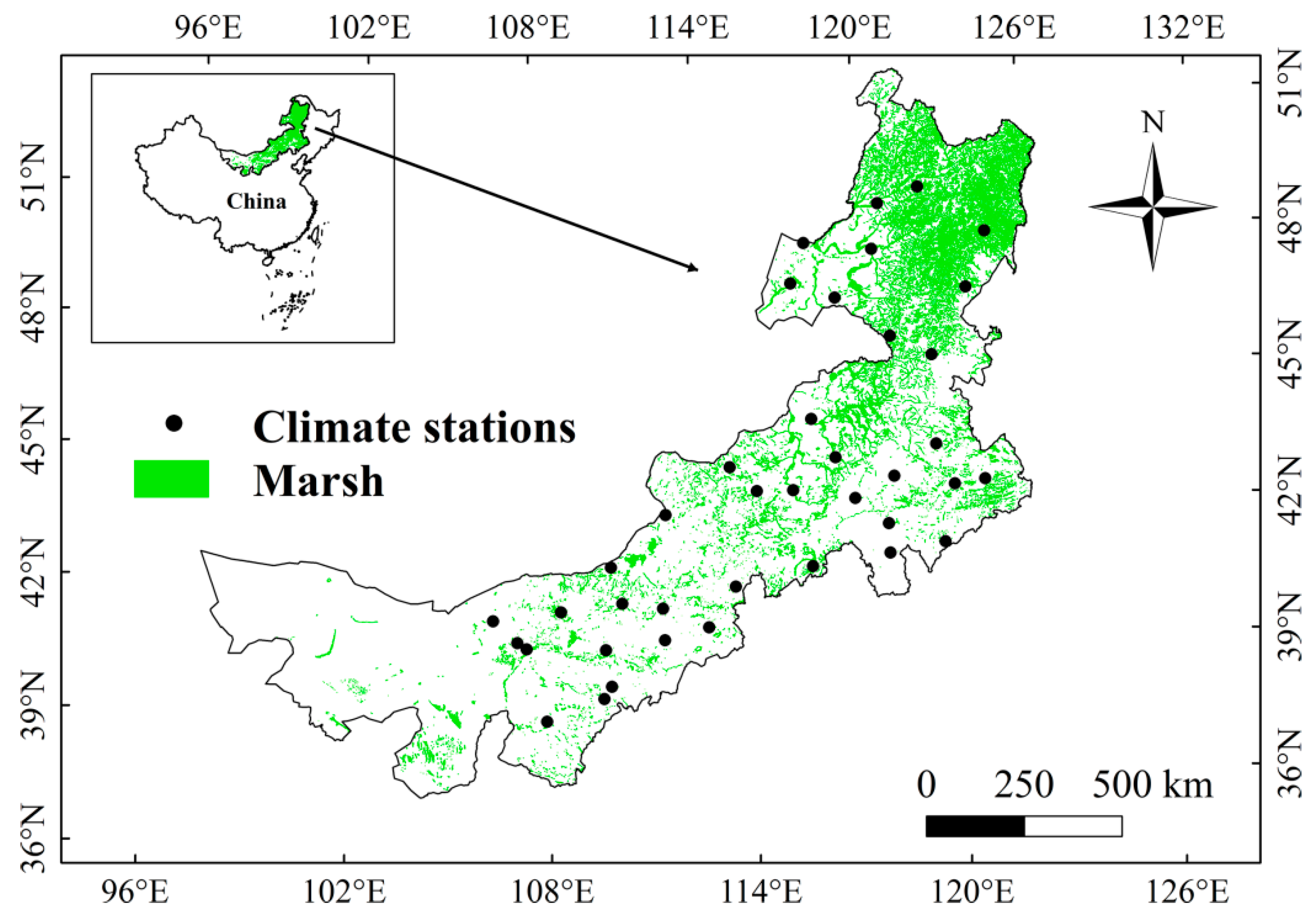
| SOS | EOS | LOS | ||||||||||
|---|---|---|---|---|---|---|---|---|---|---|---|---|
| Precipitation | Tmean | Tmax | Tmin | Precipitation | Tmean | Tmax | Tmin | Precipitation | Tmean | Tmax | Tmin | |
| January | −0.029 | −0.422 * | −0.443 * | −0.387 | −0.021 | 0.259 | 0.238 | 0.276 | 0.012 | 0.458 * | 0.464 * | 0.439 * |
| February | −0.083 | −0.272 | −0.328 | −0.251 | 0.053 | 0.133 | 0.105 | 0.140 | 0.091 | 0.278 | 0.307 | 0.265 |
| March | 0.338 | −0.691 ** | −0.734 ** | −0.618 ** | −0.121 | 0.139 | 0.152 | 0.100 | −0.323 | 0.606 ** | 0.646 ** | 0.530 * |
| April | 0.202 | −0.530 * | −0.567 ** | −0.363 | −0.192 | −0.050 | −0.025 | −0.134 | −0.253 | 0.387 | 0.428 * | 0.215 |
| May | −0.207 | −0.081 | −0.072 | −0.141 | 0.247 | −0.187 | −0.099 | −0.206 | 0.285 | −0.031 | 0.006 | 0.006 |
| June | −0.185 | 0.113 | 0.149 | −0.070 | −0.313 | 0.217 | 0.284 | −0.046 | −0.017 | −0.039 | −0.006 | −0.118 |
| July | −0.190 | −0.308 | −0.333 | −0.147 | 0.004 | 0.272 | 0.275 | 0.141 | 0.010 | 0.324 | 0.327 | 0.226 |
| August | −0.332 | −0.134 | 0.068 | −0.305 | 0.218 | 0.197 | 0.036 | 0.454 * | 0.566 ** | −0.097 | −0.328 | 0.486 * |
| September | −0.277 | −0.065 | 0.056 | −0.183 | −0.056 | 0.408 | 0.298 | 0.300 | 0.220 | 0.212 | 0.038 | 0.321 |
| October | −0.168 | 0.192 | 0.109 | 0.224 | −0.203 | 0.245 | 0.317 | 0.093 | 0.290 | −0.058 | −0.058 | −0.068 |
| November | 0.310 | −0.220 | −0.235 | −0.179 | 0.136 | −0.104 | −0.088 | −0.118 | −0.173 | 0.119 | 0.138 | 0.080 |
| December | 0.332 | −0.459 * | −0.483* | −0.446 * | −0.120 | 0.011 | 0.025 | −0.013 | −0.318 | 0.362 | 0.388 | 0.340 |
| Precipitation | Tmean | Tmax | Tmin | |
|---|---|---|---|---|
| Spring | 0.058 | 0.060 | 0.083 | 0.030 |
| Summer | 1.527 * | 0.047 | −0.024 | 0.034 |
| Autumn | 0.788 * | 0.002 | −0.023 | 0.027 |
| Winter | −0.001 | 0.031 | 0.032 | 0.028 |
| January | −0.055 | 0.038 | 0.046 | 0.032 |
| February | 0.089 | 0.006 | 0.005 | 0.006 |
| March | −0.151 | 0.098 | 0.123 | 0.066 |
| April | −0.434 | 0.039 | 0.075 | −0.018 |
| May | 0.757 | 0.042 | 0.051 | 0.042 |
| June | 0.750 | −0.040 | −0.059 | −0.009 |
| July | 0.590 | 0.042 | 0.054 | 0.035 |
| August | 3.240 ** | −0.010 | −0.067 | 0.078 ** |
| September | 1.990 * | 0.011 | −0.038 | 0.072 * |
| October | 0.266 | −0.017 | −0.018 | −0.013 |
| November | 0.109 | 0.012 | −0.012 | 0.023 |
| December | −0.093 | 0.011 | 0.012 | 0.008 |
Disclaimer/Publisher’s Note: The statements, opinions and data contained in all publications are solely those of the individual author(s) and contributor(s) and not of MDPI and/or the editor(s). MDPI and/or the editor(s) disclaim responsibility for any injury to people or property resulting from any ideas, methods, instructions or products referred to in the content. |
© 2023 by the authors. Licensee MDPI, Basel, Switzerland. This article is an open access article distributed under the terms and conditions of the Creative Commons Attribution (CC BY) license (https://creativecommons.org/licenses/by/4.0/).
Share and Cite
Liu, Y.; Shen, X.; Zhang, J.; Wang, Y.; Wu, L.; Ma, R.; Lu, X.; Jiang, M. Variation in Vegetation Phenology and Its Response to Climate Change in Marshes of Inner Mongolian. Plants 2023, 12, 2072. https://doi.org/10.3390/plants12112072
Liu Y, Shen X, Zhang J, Wang Y, Wu L, Ma R, Lu X, Jiang M. Variation in Vegetation Phenology and Its Response to Climate Change in Marshes of Inner Mongolian. Plants. 2023; 12(11):2072. https://doi.org/10.3390/plants12112072
Chicago/Turabian StyleLiu, Yiwen, Xiangjin Shen, Jiaqi Zhang, Yanji Wang, Liyuan Wu, Rong Ma, Xianguo Lu, and Ming Jiang. 2023. "Variation in Vegetation Phenology and Its Response to Climate Change in Marshes of Inner Mongolian" Plants 12, no. 11: 2072. https://doi.org/10.3390/plants12112072
APA StyleLiu, Y., Shen, X., Zhang, J., Wang, Y., Wu, L., Ma, R., Lu, X., & Jiang, M. (2023). Variation in Vegetation Phenology and Its Response to Climate Change in Marshes of Inner Mongolian. Plants, 12(11), 2072. https://doi.org/10.3390/plants12112072







